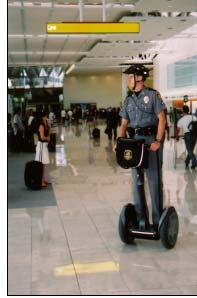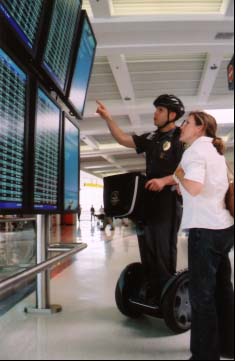|
In 2003, Captain Eric Garrison of the Maryland Transportation Authority Police at Baltimore-Washington International (BWI) Airport saw a news report about the Segway Personal Transporter (PT) and wondered if the devices would be useful for the officers who patrolled the airport. He thought that the quiet, self-balancing Segway PT might allow an officer to respond more quickly to emergencies and patrol the facility without getting fatigued. “Of all the officers on an airport shift, we have several in cars on the roadway, one or two officers on bike patrol, and several on ATV’s patrolling the acreage to the south of the airport,” says Garrison. “Other than that, all of our officers are on foot patrol, and they do a lot of walking -- an average of about 7 miles a day. They also carry and wear approximately 33 pounds of gear and equipment. At the 11th hour of a 12-hour shift you get very tired, but you still have to respond to your service calls and emergency calls like it’s the first hour. It’s tough” Authority Police at Baltimore-Washington International (BWI) Airport saw a news report about the Segway Personal Transporter (PT) and wondered if the devices would be useful for the officers who patrolled the airport. He thought that the quiet, self-balancing Segway PT might allow an officer to respond more quickly to emergencies and patrol the facility without getting fatigued. “Of all the officers on an airport shift, we have several in cars on the roadway, one or two officers on bike patrol, and several on ATV’s patrolling the acreage to the south of the airport,” says Garrison. “Other than that, all of our officers are on foot patrol, and they do a lot of walking -- an average of about 7 miles a day. They also carry and wear approximately 33 pounds of gear and equipment. At the 11th hour of a 12-hour shift you get very tired, but you still have to respond to your service calls and emergency calls like it’s the first hour. It’s tough”
In February 2004, Garrison heard about a program from the Department of Justice that helps local police departments try and evaluate the Segway PT.
“We found out that the Department of Justice had a representative named Michael O’Shea who was loaning out Segway PTs on a trial basis to see if officers would like to use them,” says Garrison. “I contacted O’Shea and we made arrangements for him to loan us 2 units and provide training. In a single day O’Shea trained about 30 officers and a couple of our commanders to use the machines. I then went ahead and put the units into service at BWI.”
“BWI began Segway PT patrols in March 2004,” recalls Garrison. “We kept them in certain areas of the airport so we could document and evaluate their use. At the end of the evaluation program we would then have a nice report that we could send to the DOJ and to our commanders. Our evaluation covered a broad range of areas: use in and around crowds, noise abatement, use in inclement weather, the durability of the unit, the field life of the batteries, feedback from the public and airport management. We also wanted to see how the units operated with officers of different heights and body weights, and explore the potential for injury to police personnel and airport patrons. Lastly we assessed the morale of the officers after they used the Segway for an entire 12-hour shift.”
 Officer fatigue was the primary reason Garrison evaluated Segway PTs at BWI, and during the four-month study he found that the devices were a perfect solution to this problem. “The Segway PT helped us respond to service calls faster and eliminated the fatigue that we normally had in a twelve hour day,” says Garrison. “We found that the officers on the units got to emergency calls three to four minutes faster than the other officers. Moreover, the use of Segway PTs put enjoyment back into foot patrols. Throughout the study the other officers were begging us to train them on the Segway PT so they could use them. We also found that the public is attracted to an officer on the Segway like a bear to honey, which greatly improves our community relations and increases our security presence.” Officer fatigue was the primary reason Garrison evaluated Segway PTs at BWI, and during the four-month study he found that the devices were a perfect solution to this problem. “The Segway PT helped us respond to service calls faster and eliminated the fatigue that we normally had in a twelve hour day,” says Garrison. “We found that the officers on the units got to emergency calls three to four minutes faster than the other officers. Moreover, the use of Segway PTs put enjoyment back into foot patrols. Throughout the study the other officers were begging us to train them on the Segway PT so they could use them. We also found that the public is attracted to an officer on the Segway like a bear to honey, which greatly improves our community relations and increases our security presence.”
According to Garrison, the Segway PT performed well in every category of the evaluation. It was quiet, easy to maneuver in crowds, and generated enthusiasm among the officers and the other airport agencies and departments. The report recommended purchase of Segway PTs as means to enhance police presence and improve response times.
In September of 2004 Chief Gary W. McLhinney of the Maryland Transportation Authority Police authorized the purchase of nine Segway PTs for the airport. Today, the units are distributed around the airport at key locations, where they are used for traffic control on the upper and lower roadways in front of the airport, and for patrolling the adjacent six-level parking garage and the expansive main terminal. According to Garrison, 95 percent of the officers assigned to patrol the airport are now fully trained on the Segway PT.
“Airport management likes the way we’re using the Segway PTs and we’ve trained two of their managers on them,” says Garrison. “The State Fire Marshals even had us train a dozen of their Fire Marshals, who are now permitted to use our units when responding to calls in their heavy bomb suits.”
BWI units are all similarly equipped with a front cargo bag, headlamps and a pedestrian alert. According to Garrison, the Segway PT nickel metal hydride batteries last approximately 10 hours when operated on the intermediate key (up to 8 mph), and approximately 12 hours – an entire shift – on the beginner key (up to 6 mph).
Call a Segway Inc. Account Manager toll-free at 1-866-4SEGWAY today to learn more about how the Segway PT can get your business rolling.
|